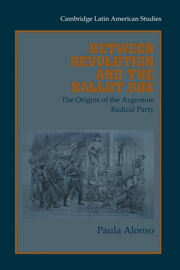Book contents
- Frontmatter
- Contents
- Acknowledgments
- List of Abbreviations
- List of Tables and Figures
- Introduction
- 1 The Political Arena
- 2 Mounting an Opposition
- 3 The Short-Lived Unión Cívica
- 4 The Radicals in Action: Part I
- 5 The Radicals in Action: Part II
- 6 The Decline of the Radical Party
- Conclusion
- Appendix 1 A Chronology of Political Parties and Factions, 1862–1910
- Appendix 2 Details of the Members of the National Committee of the UCR in 1892
- Appendix 3 Property Values in Buenos Aires, 1890–1898
- Bibliography
- Index
4 - The Radicals in Action: Part I
Published online by Cambridge University Press: 05 August 2011
- Frontmatter
- Contents
- Acknowledgments
- List of Abbreviations
- List of Tables and Figures
- Introduction
- 1 The Political Arena
- 2 Mounting an Opposition
- 3 The Short-Lived Unión Cívica
- 4 The Radicals in Action: Part I
- 5 The Radicals in Action: Part II
- 6 The Decline of the Radical Party
- Conclusion
- Appendix 1 A Chronology of Political Parties and Factions, 1862–1910
- Appendix 2 Details of the Members of the National Committee of the UCR in 1892
- Appendix 3 Property Values in Buenos Aires, 1890–1898
- Bibliography
- Index
Summary
In July 1891, the Radicals began to regroup. They had not emerged well from the frenzied bargaining of 1890–1891, losing both prominent party members and strategic positions in the provinces. By this time they had adopted the name “Radicals,” disparagingly conferred on them because of their vociferous rhetoric. They responded proudly:
Times have changed and with them they have also changed the meaning of the words to the extent that, today to seek basic freedoms and electoral guarantees has became such an intransigence, such an impertinent threat that cannot longer be done with the simplicity of the old times. For such a small matter it is necessary now to be called radicals.
This chapter analyzes who the Radicals were, what they did, and why. The first section describes Unión Cívica Radical (UCR) members and provides a profile of two of its prominent leaders, Leandro Alem and Bernardo de Irigoyen. This is followed by a close analysis of the political discourse of the Radical Party, a discourse largely reconstructed from the pages of the party's daily, El Argentino. The Radicals launched a public campaign to legitimize the use of violence against a corrupt government, which triggered an intense debate between government and opposition. The last two sections of the chapter describe the revolutionary outbreaks of July, August, and September, 1893, organized by the Radical Party. The debate of the 1890s was not merely theoretical; it was closely related to the identity and strategies adopted by the UCR.
- Type
- Chapter
- Information
- Between Revolution and the Ballot BoxThe Origins of the Argentine Radical Party in the 1890s, pp. 94 - 132Publisher: Cambridge University PressPrint publication year: 2000

